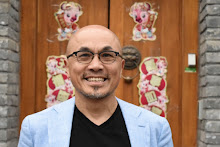
In August, my family and I went to Xinjiang for a week.
We went to the capital,
Urumqi, and the adjoining
Turfan Basin and Tianchi (
Heavenly Lake) up in the Tianshan mountain range.
Xinjiang is a huge chunk of
China.
It is bigger than
Alaska but more important to
China than
Alaska is to the
U.S. It sits on about 30% of
China’s oil reserves and adjoins that volatile but oil and natural gas-rich region known as
Central Asia.
While Xinjiang is part of China, it also stands apart from China in many ways – culturally, geographically, historically and politically speaking. Culturally, the different ethnic minorities that populate Xinjiang are Turkic-speaking people who have more in common with their Central Asian and Russian neighbors. Uighers, Kazaks, Mongols, Tajiks, Uzbeks, Russians are some of the major ethnic groups living in Xinjiang. We saw displays of these different ethnic minorities in the provincial museum in Urumqi. The food in this region is very different from typically Chinese food, and again shares more in common with Central Asia and the Middle East as you can see in some of our pictures in the Flickr website.

Geographically, this is a region that is very different from either the rice fields of southern China or the loess plains of northern China. Much of it is inhospitable land, consisting of desert or high mountains with pockets of oasis towns, as you can see from our pictures from Turfan and Tianchi.


Historically, Xinjiang has only been part of China since the Qing dynasty when the Qianlong emperor’s military campaigns succeeded in defeating the Zunghar tribes (also known as Western Mongols) that had given the Manchus fits since the start of the Qing. By 1759, with the capture of the cities of Kashgar and Yarkand at the far western edge of Xinjiang, the Qing had expanded China’s territory further than at any point in China’s history. Indeed, Xinjiang literally means "new frontier" in Chinese.
Before the Qing, this region was an important part of the Silk Road that connected China with central Asia, India, the Middle East and southern Europe. Some of the places we visited – Urumqi and Turfan – were important stopovers on the northern Silk Road. The Silk Road was not only an important conduit for the trade of goods such as silk and jade, but also for the exchange of different religions and values such as Buddhism and Islam, of which we saw many influences. Here are pictures of an ancient Buddhist stupa and relative more modern mosque as examples of those religious influences. Up the valley from that mosque were caves dug into the hillsides filled with Buddhist scupltures and art.



Politically, the inhabitants of Xinjiang have posed challenges for
China’s attempts at integrating them into the Chinese nation.
Since Xinjiang became part of
China,
China’s rulers have had to contend with Muslim uprisings.
Most recently, a group calling for the establishment of a separate Turkestan state (
Turkestan is an old name for this region) has been active in this region.
A few years ago, they conducted some bombings of buses in Urumqi and even once in
Beijing.
The government responded with a harsh crackdown, executing several leaders of the movement in Korla, the second largest city in Xinjiang just south of Urumqi.
In talking to the Uighers here, you certainly sense resentment of Chinese control, especially of the oil resources.
Uighers often learn their own language in schools and are not required to learn Mandarin.
As a result, Xinjiang is a satisfying place for Americans to go because you feel this is one place in
China where the natives speak Chinese about as well you as do!
But they love it also when you try to speak Uigher with them.
We had a great time in Xinjiang, and only wish we could have had more time. We will definitely be back. A few impressions about Xinjiang from our brief time there.
Xinjiang is huge. One week was clearly not enough to see this enormous province. We only travelled around central Xinjiang, but there is a very different Xinjiang to the north and particularly to the south where the southern Silk route winds around the Taklamakan desert to meet the high mountains separating Xinjiang from India, Pakistan and Afghanistan. We also never got to the far western city of Kashgar and its famed bazaar which is seen as a meeting point of Eastern and Western cultures.
A sense of how much Xinjiang is not a part of China and the challenges that face China in integrating this province and making the Uighers and other minorities feel that they are Chinese above all else. Urumqi was the only city where one felt that this integration and Chinese settlement was working. Urumqi was not that different from other Chinese cities, increasingly modern and quite liveable.
The natural beauty of the region. Getting out of the polluted environs of Beijing, we were struck by the clear, blue skies especially in the high altitudes of Tianchi, and the unspoiled beauty of the mountains and desert. At the same time, the life of many of the people outside of Urumqi is not that easy. Life looked pretty spartan in the village of Tuyoq, although the explosion of the Chinese tourist industry seems to be bringing money into this region.
 In August, my family and I went to Xinjiang for a week. We went to the capital,
In August, my family and I went to Xinjiang for a week. We went to the capital, 



 Politically, the inhabitants of Xinjiang have posed challenges for
Politically, the inhabitants of Xinjiang have posed challenges for 
